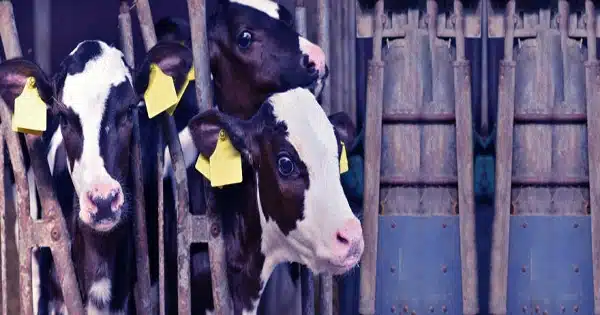To put it frankly, the meat industry is unbelievably brutal. Every day, billions of animals in the United States exist in deplorable conditions: hardly able to move, in chronic discomfort, and many never seeing the outside world before being herded, terrified, and suffering, to their agonizing, premature deaths.
Regarding the “ethically sourced” or “humane” designations, the United States Department of Agriculture reports that just 1% of livestock animals in the country reside outside of factory farms.
“I love animals,” some of you may protest. “I’m not a bad person just because I eat meat!”
You would not be alone. The vast majority of us claim to be animal lovers: approximately nine-tenths of Americans feel animals should be protected from injury and exploitation. A reasonable number of people believe animals deserve the same protection as humans. More than half of Americans own pets, and nearly one out of every twenty dollars donated to non-religious groups goes to animal charities. Studies have even discovered that we empathize more with dogs than with other people.

Nonetheless, meat consumption has never been higher in the United States or anywhere else in the globe. Although the number of vegans has increased dramatically over the last 15 years, they still account for barely 2 to 6 percent of the American population.
What explains the meat paradox?
This isn’t just an attempt to make meat-eaters feel bad. The meat paradox is one example of a psychological conflict that we all confront daily: cognitive dissonance.
“[It’s] the inconsistency between our belief that animals are cute, and we need to protect them and we probably shouldn’t torture them, and on the other hand, eating them and turning them into meat – and in the process, putting them in factory farms and torturing them in various ways,” Dr. Julia Shaw, a psychologist, explained to BrainCraft.
“Those two beliefs contradict one other. “That’s what we call cognitive dissonance,” she said. “[When] we hold two beliefs at the same time, and a paradox lies in the middle.”
To have a better understanding of this phenomenon, consider going back to the beginning, which in this case is Stanford University in the late 1950s. There, attracted by accounts of odd conduct in India some years earlier, a social psychologist named Leon Festinger set out to prove something fundamental about human nature that had previously been utterly missed.
“[There was] an especially severe [earth]quake in the province of Bihar, India, on January 15, 1934,” Festinger wrote in his seminal 1957 book, A Theory of Cognitive Dissonance. “The strong and sustained quake was felt throughout a large geographical area. The damage was mostly limited to a certain area. Although the earthquake caused shock, there was no visible damage or destruction.
You might think that a lack of obvious damage would reassure those who had recently survived an earthquake, but you’d be mistaken. People panicked, and not only because of the quake they’d just felt; tales spread about a slew of other, purportedly coming, tragedies that were even worse.
Festinger noted that these emotions “do not entirely agree with so-called common sense.” After all, why should the existence of an earthquake cause people to disseminate and believe dangerous rumors?
The solution, he reasoned, was not that they were trying to scare people, but that they were already terrified. These rumors were “fear-justifying”: people used rumors about impending disasters to subconsciously resolve an internal contradiction between their feelings of fear and the lack of something obvious to fear.
Discovering cognitive dissonance: Festinger performed what is now considered the classic demonstration of cognitive dissonance in 1959, alongside coworker James Merrill Carlsmith. In their now-famous study, the team encouraged participants to do two onerous tasks meant to elicit negative opinions. The tasks themselves were unimportant; the true experiment was what occurred next.
As the study participants left, they were given one final instruction: inform the next subject that the things they had just spent an hour of their lives doing were “very enjoyable,” “intriguing,” or even “exciting.” They received either $1, $20, or nothing in exchange for telling this blatant falsehood.
As one might imagine, those who paid nothing found the experiment dull, unenlightening, and insignificant. But what about the folks who received payment?
Well, this is where things become interesting. The group that was given $20 was quite open about not enjoying the exercises, and in terms of scientific significance, they ranked the experiments even lower than the control group.
The outliers were the people who received only one dollar. These guys found the tasks more entertaining than the other two groups, believed the experiments were more important, and were the only ones who said they’d perform the study again. What was happening?
Shaw argued that those who received $20 might justify their lying because they were compensated for it. “What if you were only paid $1? That isn’t enough to make you believe that excuses are lies.”
So, “change how you feel about the task,” she said. “You instead think, ‘You know what, … I had a pretty good time.'”
Essentially, the participants’ brains had been confronted with two contradictory, but equally truthful, ideas: they hadn’t had fun, yet they claimed to have. One of those things had to alter for the disagreement to be settled, and since words cannot be undone, the only choice was for the subjects’ perspectives on the jobs to shift.
The meat paradox: Understanding cognitive dissonance raises questions about seemingly “normal” conduct.
According to scholars Brock Bastian and Steve Loughnan, society is “shaped by attempts to resolve dissonance” and allows “morally troublesome behaviors to vanish into the commonplace and every day.”
Consider the meat paradox. If you consider yourself an animal lover, it can be upsetting to be reminded that innocent piglets suffered and died for the BLT you’re holding. How can we cope with this?
The answer is simple: just go to any grocery to find it.
“The industry’s presentation of meat influences our propensity to consume it. Our hunger is influenced by both what we term the meal we eat and how the meat is presented to us,” said Jonas Kunst, co-author of a 2016 research on the meat conundrum. “Highly processed meat removes the connection to animal origins… People were less concerned about it being an animal, felt less empathy and revulsion, and were less likely to adopt a vegetarian alternative.”
To overcome the dissonance between “I love animals” and “I love meat,” we have two options: either admit we don’t like animals or give up meat. Most of us find neither appealing, so we choose option three: pretend the two ideas have no connection.
According to Sarah Gradidge, the first author of a recent review paper on the meat paradox, reminding people of the animal origins of their meat can be triggering. This is because people often forget about the animal’s existence when eating meat.
According to her, people tend to reach for a handful of strategies to help them cope with their cognitive dissonance from eating meat: they may reclassify some animals as “food” animals, which are somehow less able to think, feel, or understand (this is not true, by the way), or they may use “the four Ns” – saying that meat is nice, normal, necessary, or natural.
“As soon as you remind people that meat comes from animals, this can trigger that discomfort, because it stops their ability to dissociate,” says Gradidge. “It reminds them of where [the meat] is coming from.”
However, the meat paradox extends beyond meat. There are numerous examples of how humans use doublethink to justify a morally problematic decision. We care about the environment, for example, but we continue to use air travel and buy vehicles because we enjoy vacations and dislike walking for hours. We, as a society, “think that it’s not OK to underpay people or to put people in really dangerous working conditions,” he said, “yet we show up at cheap shops and we buy things that are cheap just because of the price tag.”
Can we overcome cognitive dissonance?
It may seem difficult to take any conclusion from the meat conundrum that isn’t a damning indictment of humanity. According to psychologist Steve Loughnan, most people are hesitant to deny themselves the enjoyment of eating meat, therefore denying animals moral rights allows them to consume with a clear conscience.
However, cognitive dissonance, and our ability to overcome it, does not have to be a negative experience. Princeton researchers discovered a strategy to employ cognitive dissonance to induce mask-wearing and social isolation, thereby slowing the spread of COVID-19.
In Houston, the phenomenon is being utilized to prevent college students from binge drinking, while experts in New York believe it could help Internet addicts cut their internet usage.
“It’s very uncomfortable to have inconsistency in your values and behavior,” said Professor Clayton Neighbors, the Houston study’s author. “If you create discrepancies within people it will motivate them to change, at least theoretically.”
And if you don’t want to change, at least be honest with yourself, suggests Shaw.
“Meat is one good example where there’s lots of excuses,” she went on to say. “We’re constantly telling ourselves a story that it’s okay … because everybody else is doing it because there’s this industry and it’s not our problem.”
“We [should] at least accept that we’re being hypocritical,” she said. “Don’t be angry…” When someone challenges us and suggests there is an issue with our behavior. Instead, we should reflect on our conduct and, if it is inconsistent, make changes. We cease consuming as many animal products, polluting the world excessively, and buying cheap items solely for the sake of the price.”
















